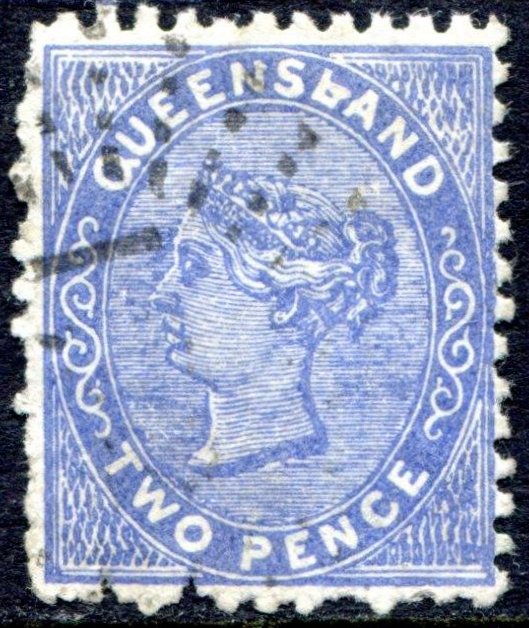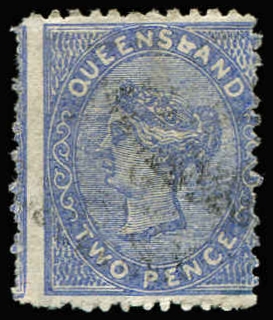This is an extract from Queensland Postage Stamps 1879 to 1912 by Kenneth Scudder, 2013, pp. 45-7 covering the essays produced for a permanent half penny stamp, which was subsequently not required and so was never produced or postally used.
Images of these essays can be seen here:
A PERMANENT HALF-PENNY STAMP
The provision of a permanent Half-penny stamp was
immediately put into operation and, as the matter was of some urgency, it was
decided to print by lithography, using an existing copper die engraved by
William Knight.
The initial design of this Half-penny stamp consisted of an
engraved profile of the Queen's head on a ground of vertical lines in an oval
frame, surrounded by a broad oval band of engraving simulating engine turned
lines. The words "HALF PENNY" were at the top and
"QUEENSLAND" at the bottom, in tablets, respectively above and below
the broad oval band. The tail of the "Q" of "QUEENSLAND"
was to the left, although this appears to have remained unnoticed for some
time. The whole was enclosed in an outer frame with the four corners rounded.
It is curious that this is the only Queensland design in which the value has
been placed above the name Queensland.
The Queen's head has been copied from that on the Southern &
Western Railway parcels stamps of 1867, the dies of which are believed to have
been engraved by William Knight. The size of the head has been reduced to 72%
of the original. Although the engraving follows very similar lines, being
smaller, there are fewer lines in some places. With Knight also being a
photographer, it is possible he used this method to obtain the reduced dimensions
to follow in the new engraving.
imperforate essays are known on a thick wove paper in black
and red, and on the 2nd Type "Crown over Q" watermarked paper in dull
purple, bright blue, vermilion and scarlet. In these the watermark is sideways.
In the Royal Collection is a pair in scarlet with, in the wide selvedge above, "Adopted
/26 : 2 : 80" and "Specimen /Essays" in manuscript.
This must have been immediately withdrawn, as further essays
were produced in which the shading around the head was removed. There are
paired essays in black on thick paper, and in blue and dull purple on watermarked
paper, with the watermark sideways. In these pairs one has a shaded background
and the other a clear background, although both still have the "Q"
reversed.
Finally, the mistake in the "Q" was noticed. This
was corrected, and lithographic transfers were taken of the unshaded background
design and laid down on a stone from which a sheet of 120 could be printed.
Basset Hull wrote that proof sheets were printed in black, purple, blue,
orange, vermilion and scarlet on plain and watermarked paper and submitted for
approval. The watermark was the 2nd Type "Crown over Q", upright.
In the Australia Post Archival Collection, Melbourne, is an
imperforate piece showing two horizontal rows of 10, printed in vermilion with
each stamp lightly overprinted "SPECIMEN", Type 1. It bears the date
27.2.80, and a signature which presumably is the signature of approval,
although it may be the signature of the printer. In any event, it was dated the
day before the Half-penny stamp was cancelled.
With only seven days elapsing from the notification on the 20
February that a new Half-penny stamp was required to the final production of a
sheet or two from a lithographic stone, it would seem highly unlikely, if not impossible,
to complete even the initial engraving in this time. It would seem that the die
of the initial design must have already been in existence.
At least one Essay for a Postcard exists with this
Half-penny design in which the head is on a cleared background and the
"Q" has the corrected tail. Although this indicates it was produced
sometime after the stamps in question, the connection to the Postcard is
important.
The Post Office had long been interested in having Postcards and this was only delayed until the necessary legislation was passed.
Approval was finally given in the Postcard and Postal Note Act, 1880, which
came into force on 1 October 1880.
It would seem then that a die for the initial design of this
Half-penny stamp must have been in existence prior to February 1880. This would
explain how the proof sheets were produced in such a short time. It may also explain
why this design was so different to the then current issue postage stamps.
Also needing some explanation is the apparent speed in which
it was possible to correct the reversed tail to the "Q". Because the
intended printing process was to be lithography, it was a simple matter to fill
in the unwanted tail and engrave a new one, as very little pressure was
required between the transfer paper and the die. In this correction a small tell-tale
mark was left inside the "Q".


















































